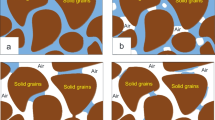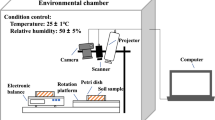Abstract
A physically-based dual-porosity model of water and solute transport under transient field conditions was used to simulate3H transport in seven undisturbed monoliths of a coarse-textured sand under bare soil conditions over a period of 15 months. A double-tracer application of3H and36Cl was performed to test whether sidewall flow occurred in this experimental set-up. The objectives of this study were: to identify any impacts of preferential flow in this type of soil, to quantify3H losses from the soil due to evaporation, and to assess the suitability and relative behavior of3H and36Cl as tracers of water. The model input parameter values were obtained by a combination of direct measurements and model calibration. One domain flow simulations of water flow and tracer concentrations in seepage agreed fairly well with those observed, indicating convective-dispersive behavior in this sandy soil. From the observed tracer and water balance for the entire observation period, the recovery of3H and36Cl in seepage was 33 and 91% respectively, with 67% of the applied H lost by evaporation. Both3H and36Cl broke through in seepage simultaneously, showing that36Cl is equally suitable as a tracer of water as3H. The double-tracer test showed that sidewall flow did not occur.
Similar content being viewed by others
References
Ankeny, M. D., Ahmed, M., Kaspar, T. and Horton, R.: 1991, ‘Simple Field Method for Determining Unsaturated Hydraulic Conductivity’,Soil Sci. Soc. Am. J. 55, 467–470.
Athavale, R. N., Murti, G. S. and Chand, R.: 1980, ‘Estimation of Recharge to the Phreatic Aquifers of the Lower Maner Basin, India, by Using the Tritium Injection Method’,J. Hydrol. 45, 185–202.
Bahadur, J., Saxena, R. K. and Mookerjee, P.: 1977, ‘Soil Moisture Movement and Ground Water Recharge by Tritium Tracer Tagging Technique”,Proc. Indian Acad. Sci., Section A 85, 462–471.
Beven, K. and Germann, P.: 1982, ‘Macropores and Water Flow in Soils’,Water Resourc. Res. 18, 1311–1325.
Booltink, H. W. G., Hatano, R. and Bouma, J.: 1993, ‘Measurement and Simulation of Bypass Flow in a Structured Clay Soil — A Physico — Morphological Approach’,J. Hydrol. 148, 149–168.
Brooks, R. H. and Corey, A. T.: 1964,Hydraulic Properties of Porous Media. Hydrology Paper No. 3, Colorado State University, Fort Collins.
Butts, M. B., Genders, S. and Sevel, T.: 1988,Radio Tracer Studies of Solute Transport in the Unsaturated Zone: Field Measurements and Analysis, Danish Isotope Centre, Copenhagen.
Datta, P. S. and Goel, P. S.: 1977, ‘Groundwater Recharge in Panjab State (India) Using Tritium Tracer’,Nord. Hydrol. 8, 225–236.
Gerke, H. H. and van Genuchten, M. T.: 1993, ‘Evaluation of a Ist-Order Water Transfer Term for Variably Saturated Dual-Porosity Flow Models’,Water Resourc. Res. 29, 1225–1238.
Ghodrati, M. and Jury, W. A.: 1990, ‘A field Study Using Dyes to Characterize Preferential Flow of Water’,Soil Sci. Soc. Am. J. 54, 1558–1563.
Jarvis, N. J.: 1991, MACRO, Dept. Soil Sci., Swedish Univ. Agric. Sci., Uppsala, Sweden.
Jarvis, N. J.: 1994, MACRO, Dept. Soil Science, Swedish Univ. Agric. Sci. Uppsala, Sweden.
Jarvis, N. J., Bergström, L. and Dik, P. E.: 1991, ‘Modelling Water and Solute Transport in Macroporous Soil. 2. Chloride Breakthrough Under Non-Steady Flow’,J. Soil Sci. 42, 71–81.
Kung, K-J. S.: 1990, ‘Preferential Flow in a Sandy Vadose Zone. 1. Field Observation’,Geoderma 46, 51–58.
Lundin, L.: 1982,Soil and Groundwater in Moraine and Influence of Soil Type on Run-off, UNGI Report 56, Dept. of Phys. Geography Uppsala Univ.
Messing, I. and Jarvis, N. J.: 1993, ‘Temporal Variation in the Hydraulic Conductivity of a Tilled Clay Soil as Measured by Tension Infiltrometers’,J. Soil Sci. 44, 11–24.
Mualem, Y.: 1976, ‘A New Model for Predicting the Hydraulic Conductivity of Unsaturated Porous Media’,Water Resourc. Res. 12, 513–522.
Omoti, U. and Wild, A.: 1979, ‘Use of Fluorescent Dyes to Mark the Pathways of Solute Movement Through Soils Under Leaching Conditions. 2. Field Experiments’,Soil Sci. 128, 98–104.
Persson, L. and Bergström, L.: 1991, ‘Drilling Method for Collection of Undisturbed Soil Monoliths’,Soil Sci. Soc. Am. J. 55, 285–287.
Saxena, R. K. and Dressie, Z.: 1983, ‘Estimation of Groundwater Recharge and Moisture Movement in Sandy Formations by Tracing Natural Oxygen-18 and Injected Tritium Profiles in the Unsaturated Zone’, inIsotope Hydrology 1983, STI/PUB/650, IAEA, Vienna, pp. 139–150.
Starr, J. L., DeRoo, H. C., Frink, C. R. and Parlange, J-Y,: 1978, ‘Leaching Characteristics of a Layered Field Soil’,Soil Sci. Soc. Am. J. 42, 386–391.
Thomas, G. W. and Phillips, R. E.: 1979, ‘Consequences of Water Movement in Miscropores’,Environ. Qual. 8, 149–152.
Valocchi, A. J.: 1990, ‘Use of Temporal Moment Analysis to Study Reactive Solute Transport in Aggregated Porous Media’,Geoderma 46, 233–247.
van Dam, J. C., Hendrickx, J. M. H., van Ommen, H. C., Bannink, M. H., van Genuchten, M. T. and Dekker, L. W.: 1990, ‘Water and Solute Movement in a Course-Textured Water-Repellent Field Soil’,J. Hydrol. 120, 359–379.
van Genuchten, M. T.: 1985, ‘A General Approach for Modelling Solute Transport in Structured Soils’.Mem. Int. Assoc. Hydrogeol,17, 513–526.
van Genuchten, M. T. and Dalton, F. N.: 1986, ‘Models for Simulating Salt Movement in Aggregated Field Soils’,Geoderma 38, 165–183.
Whitmore, A. P.: 1991, ‘A Method for Assessing the Goodness of Computer Simulation of Soil Processes’,J. Soil Sci. 42, 289–299.
Yates, S. R., van Genuchten, M. T., Warrick, A. and Leij, F.: 1992, ‘Analysis of Measured, Predicted, and Estimated Hydraulic Conductivity Using the RETL Computer Program’,Soil Sci. Soc. Am. J.,56, 347–354.
Zimmermann., U., Munnich, K. O. and Roether, W.: 1967, ‘Downward Movement of Soil Moisture Traced by Means of Hydrogen Isotopes’, in G. E. Stout (ed.),Geophysical Monograph No. 11,Isotope Techniques in Hydrological Cycle, American Geophysical Union, Washington; pp. 221–230.
Author information
Authors and Affiliations
Rights and permissions
About this article
Cite this article
Saxena, R.K., Jarvis, N.J. Measurements and modeling of tracer transport in a sandy soil. Water Air Soil Pollut 79, 409–424 (1995). https://doi.org/10.1007/BF01100450
Received:
Accepted:
Issue Date:
DOI: https://doi.org/10.1007/BF01100450




